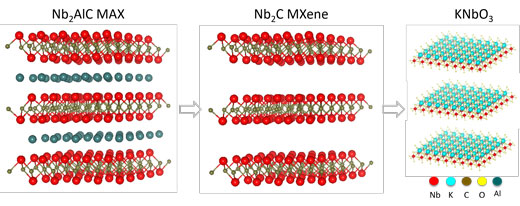| Feb 25, 2019 | |
Plate-like ferroelectric crystals synthesized with the help of MXenes |
|
| (Nanowerk Spotlight) Potassium niobate (KNbO3) is a a perovskite ferroelectric crystal that, due to its optical properties, has been found useful in many different areas of materials science research, including electro-optics, piezoelectric, and electronic applications. | |
| Unlike the wire- or rod-like KNbO3 crystals synthesized so far, it is hard to make plate-like (rectangular) ferroelectric crystals. However, this shape would be very advantageous because it could be easily mounted in optical applications and devices. | |
| Previous attempts to make KNbO3 crystals by hydrothermal synthesis using Nb2O5 and KOH as precursors, even with SDS as surfactant, only resulted in needle-like crystals. | |
| Unlike these previously reported results, researchers have now, for the first time, succeeded in producing large KNbO3 crystals with uniform flat shape, and c-axis texture (for some applications it is advantageous for certain crystal directions to be perpendicular to the surface), which makes the crystals useful for practical electro-optic applications. | |
| "Because MXenes have 2D morphology – i.e. graphene-like two-dimensional structures – we discovered that if we use them as precursor materials to grow ferroelectric crystals, their 2D nature is inherited by the ferroelectric crystals," Husam N. Alshareef, a professor at King Abdullah University of Science and Technology (KAUST) in Saudi Arabia, tells Nanowerk. "This allows us to make high aspect ratio plate-like ferroelectric crystals, which has been difficult to do so far." | |
| The team reported their findings in Advanced Materials ("MXene-Derived Ferroelectric Crystals"). | |
 |
|
| Strategy used to prepare high aspect ratio ferroelectric crystals (KNbO3) from MXenes. (Image: Functional Nanomaterials & Devices Group, KAUST) (click on image to enlarge) | |
| Basically, with this synthesis method, the ferroelectric crystals, although thicker, inherit the 2D characteristic of the MXenes. The result are high-quality plate-like KNbO3 crystals with high aspect ratio, which are required in microelectromechanical and integrated photonic applications, | |
| The size of the MXene-derived KNbO3 crystals ranges from few micrometers to 40 micrometers due to the differential crystal growth based on different MXene precursors. It can be optimized by adjusting the size and uniformity of MXene flakes. | |
| "Our new method of conversion of MXenes (Nb2C) into KNbO3 by the hydrothermal synthesis is simple, versatile and can be applied for the synthesis of other ferroelectric perovskites, e.g. LiNbO3 and NaNbO3," notes Shaobo Tu, PhD student and lead author of the study. | |
| The platelet-like MXene-derived KNbO3 crystals can be used to fabricate textured KNbO3 ceramics with advanced ferroelectric, piezoelectric, and dielectric properties due to their high aspect ratio and robust ferroelectricity. | |
| The next stages in the team's investigations will be the synthesis of other Nb2C MXene derived ferroelectric crystals, e. g. LiNbO3, NaNbO3, KxNa1-xNbO3 and the study of their optical properties. | |
| "One of the most important future direction for our research field is the design and synthesis of MXene derived ferroelectric ultrathin films for the fabrication electronic devices," Alshareef concludes. "The particular challenges we are facing at the moment, but which we hope to overcome, is the relative large surface roughness of synthesized thin film due to the uneven distribution of MXene flakes on the substrate." | |
 By
Michael
Berger
– Michael is author of three books by the Royal Society of Chemistry:
Nano-Society: Pushing the Boundaries of Technology,
Nanotechnology: The Future is Tiny, and
Nanoengineering: The Skills and Tools Making Technology Invisible
Copyright ©
Nanowerk LLC
By
Michael
Berger
– Michael is author of three books by the Royal Society of Chemistry:
Nano-Society: Pushing the Boundaries of Technology,
Nanotechnology: The Future is Tiny, and
Nanoengineering: The Skills and Tools Making Technology Invisible
Copyright ©
Nanowerk LLC
|
|
|
Become a Spotlight guest author! Join our large and growing group of guest contributors. Have you just published a scientific paper or have other exciting developments to share with the nanotechnology community? Here is how to publish on nanowerk.com. |
|
